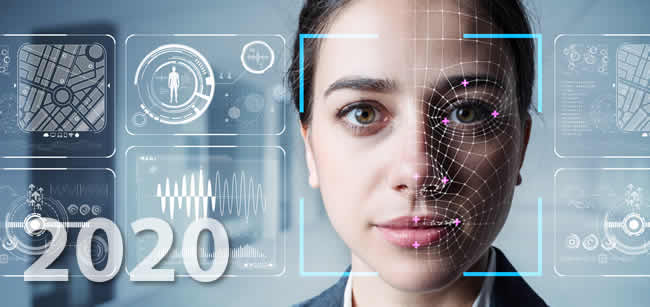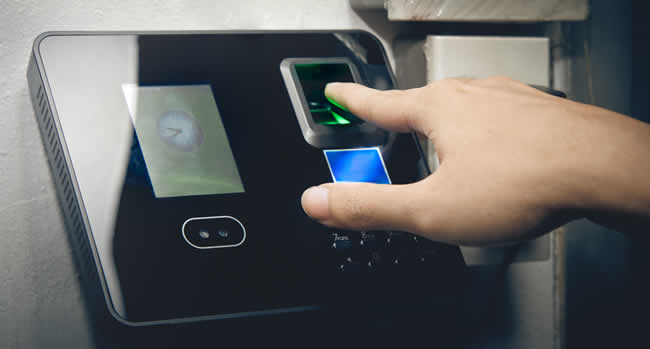The biometrics market will be significantly impacted by the COVID-19 pandemic. While contact-only biometrics companies will suffer most, others have adapted with, for instance, contact-less fingerprint sensing solutions. Yet, the main ‘gains’ for the biometrics market in 2020 are for artificial intelligence biometric firms and AI facial recognition investments. The overall biometrics market nevertheless takes a hit as COVID accelerates digital transformation in some areas.
Biometric technologies are currently undergoing a forced evolution rather than an organic one, with artificial intelligence biometric firms spearheading the charge (Dimitrios Pavlakis, ABI Research)
On top of its human toll and impact on all areas of society, the COVID-19 pandemic obviously also has consequences on the ICT market, manufacturing, supply chains, the ways we look at our built environment, physical security, digital health and so much more. One of the fields that has a place in all these mentioned – and other domains – is biometrics.
And the pandemic is clearly changing the dynamics in biometrics and the overall biometrics market in 2020 – and, no doubt, beyond. As organizations are accelerating digital transformation efforts in several areas, with work/HR, education, government, and digital healthcare belonging to the more obvious ones, the real impact of COVID-19 – and how we responded to it – on the longer-term remains to be seen. Yet, in biometrics, the usage of recognition devices, and facial recognition, the impact becomes more apparent each day.

The biometrics market in a contact-less world
With several countries and regions looking to start up the activities in the ‘physical’ world again, the usage of biometric techniques becomes even more important as we slowly come outside of our bubbles where ‘digital’ proved vital. True, this doesn’t mean digitization and digitalization will go back to previous levels. And there is always the unknown.
We can expect the increased adoption of (platforms for) digital marketing, online education/training, e-commerce, virtual events, and remote work, to name just some, to have a lasting impact. And, in the end, we still live in a non-binary world where physical and digital are terms that decreasingly make sense as everything slowly converges as in the cyber-physical notion in Industry 4.0. But biometric technologies will nevertheless play a significant role in any evolution, even if only a limited number of people can go back to offices, restart production in factories (no matter how ‘smart’ they are said to be), move around and travel, or be in all sorts of facilities where biometrics isn’t just about security and recognition anymore, but also about health and prevention. In other words: biometrics are poised to become even more important in the digital transformation strategy of organizations as we enter a changed world.
Physical distancing and the avoidance of health risks through ‘touch’ will continue to exist for some time. The final words on how this evolves in today’s more contact-less environment – for now – will be for governments, all taking different views and having a more significant say than ever in technological evolutions and directions.
The avoidance of physical contact and more, specifically, touching objects/surfaces others have touched inevitably has consequences for several areas of biometrics. You can imagine that people, governments, and organizations will want to avoid contact biometric technologies precisely because of rules regarding contact but certainly also out of fear.
This is precisely what is already happening according to research that shows facial recognition is on the rise while biometric device shipments are dropping because of COVID-19. Especially the ‘more basic’ contact biometric technologies are affected. Disinfection and supervision to make sure all is used as it should be aren’t always easy or even feasible.
The biometrics market and our built environment
The usage of face recognition technologies in our built environment, of course, was already on the rise, with some regions clearly sticking out in the growth of the facial recognition market.
The total biometric device market is expected to reach US$28.2 billion in 2020, with the government and security market taking a significant hit of US$1.1 billion. Fingerprint device sales are also expected to decrease in 2020 by US$1.2 billion.
And it’s just the beginning. Before the crisis hit, Berg Insight said that the first significant area where the combination of 5G and the Internet of Things in the coming age of fast cellular IoT will have a considerable impact is homeland security, with a considerable impact on our big data environments.
Building system integrators who have gone beyond traditional building automation already transformed their business to meet rising demand. Take US-based Wadsworth Solutions. In an interview on building system integration, executive Jeff Groat explained how analytics, artificial intelligence, and edge technology (along with better, ‘smarter’ CCTV cameras) already drive demand and potential, as the company works on a 600-camera security system in Cleveland International Airport.
In the same interview, Martin Feder added that building systems are going to move more into an AV communication world where camera technology is linked to face recognition.
While Groat said that he was almost bewildered to see how biometrics, iris readers, and fingerprint and finger vein readers are taking off in building security with built-in IoT connectivity, those fingerprint and finger vein readers requiring contact might now see a slowdown for the mentioned reasons. The exception: those who worked to have contact-less fingerprint sensing solutions. At the same time, the face recognition technologies both interviewees talked about in the context of building system integration evolutions might pick up way faster.
And it’s not just in security-classified facilities or for law enforcement; it’s also in retail facilities, travel (airports, stations,…), public buildings, healthcare facilities, and so forth. Moreover, there are more reports on how advanced biometrics technologies are getting used in the scope of the current crisis in several new ways you no doubt have read or heard about.

The contact biometrics market declines as new needs lead to shifts in investments
What the impact of this crisis on the long run will be on biometrics is still to be seen. Again: governments will have a more influential say than ever, and you’ll see quite some differences in how and why which technologies are adopted for what purposes and with what regulations to keep in mind. Typically we see countries that are closer to each other taking similar measures.
Yet, for 2020, it’s clear that the market of contact biometrics declines while that of face recognition technologies will accelerate. According to ABI Research, the COVID-19 pandemic will cause a significant pushback on the shipments of biometric devices with a revenue drop of $2 billion throughout 2020.
The growing need for new identification and surveillance needs, driven by the crisis as ABI Research emphasizes, on the other hand, is expected to increase investments in biometric AI algorithm design, which in turn boos the face recognition technology market. That increased funding is perhaps why there are some dubious announcements from researchers where facial profiling comes to mind again.
ABI Research analyst Dimitrios Pavlakis particularly points to contact biometric technologies such as fingerprint and vein reading in commenting on the factors that give a blow to biometric device shipments and overall revenue drop. These factors indeed include new government regulations regarding (physical) contact and also close-proximity interactions.

Moreover, according to Pavlakis, the vendors of fingerprint biometrics have a hard time upholding stringent hygiene and infection control protocols that have been put in place in various countries.
Pavlakis reminds us how widespread such technologies already are. “On-premises physical access control, user registration, identification, and workforce management systems have been greatly affected in the enterprise and commercial space, but these applications also spread into healthcare, law enforcement, border control, government, civil, and welfare.”
Contact-only biometrics companies have other hurdles to overcome as well. In contrast, innovators such as Gemalto and IDEMIA have adapted with solutions that offer contact-less fingerprint sensing technologies, he adds.
The biometrics consumer market in 2020 – fingerprint sensors and smartphones
Biometrics, of course, isn’t just about facilities such as commercial real estate or smart factories and physical security in business markets, airports, smart cities and communities alone. Here, ABI Research points to the fact that fingerprint sensor vendors in consumer markets are most affected by sales of smartphones instead of hygiene concerns. The company points explicitly to the personal nature of user authentication.
It should also be noted that the COVID-19 pandemic has strongly affected smartphone sales. According to IDC, the smartphone market in China had its most significant decline ever in the first quarter of 2020, with shipments dropping a whopping 20.3 percent year over year.
And it’s not China alone: also on a global level the year-over-year decline in smartphone shipments was the largest ever in Q1 2020 with a decrease of 11.7 percent. One of the exceptions is India, where smartphone sales posted a 1.5 percent growth in Q1, compared to the same period in 2019. In the US, shipments declined with 16 percent.
All these elements together indeed don’t exactly spell good news for biometrics vendors with a specialization in fingerprint sensors for consumers (mainly smartphones) like Goodix.
Artificial intelligence biometric firms in the overall 2020 biometrics market
The overall biometric device market is expected to reach US$28.2 billion in 2020 per ABI Research.
Fingerprint device sales are expected to decrease by US$1.2 billion, and the government and security market is expected to take a significant hit of US$1.1 billion.
Yet, for the biometrics market as a whole, the good news comes from those growing investments in AI recognition applications. There is also the – forced – evolution in biometric technologies with artificial intelligence biometric firms spearheading the charge per Pavlakis (even to predict potential future outbreaks).
Pavlakis. “New IoT and smart city-focused applications will enable new data streams and analytics, monitoring infection rates in real-time, forcing new data-sharing initiatives, and even applying behavioral AI models to predict future outbreaks.”
It’s clear that debates about biometric data (highly sensitive personal data) protection will also accelerate in certain parts of the world as governments take more initiatives regarding novel technologies and applications as a consequence of COVID-19.
More findings and details in the ABI Research report “Assessing the Impact of COVID-19 on the Biometrics Market“.

